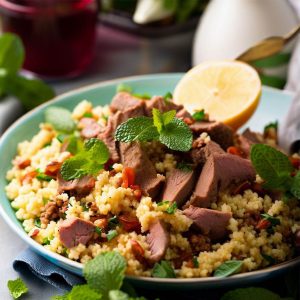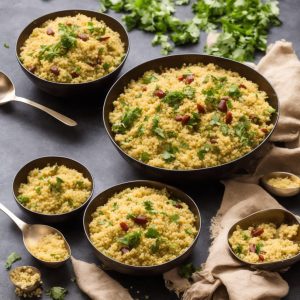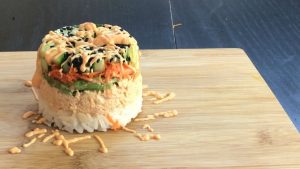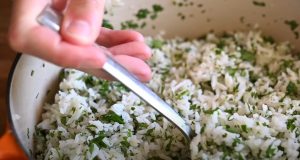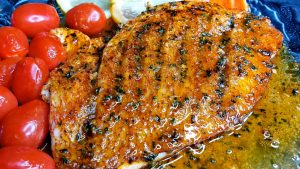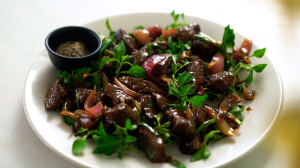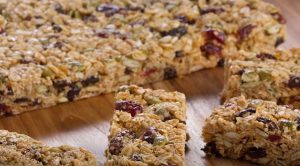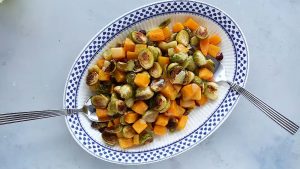This Moroccan Chicken Couscous recipe is a vibrant blend of spices, vegetables, and tender chicken. The warming spices and varied textures make this a feast for the senses, suitable for a family meal or a special occasion.
Some of these ingredients may not be in your pantry, such as cardamom and allspice. While these are common spices in Moroccan cuisine, they may not be as familiar to other culinary traditions. You can find these at most supermarkets in the spice aisle. Additionally, garbanzo beans and couscous are key to this recipe, providing a robust backbone to the dish.
Ingredients for Moroccan Chicken Couscous with Vegetables
Cumin: A warm, earthy spice that's the backbone of Moroccan cuisine.
Ginger: A pungent and spicy root that adds a zesty kick.
Cloves: A sweet and aromatic spice that adds depth.
Cayenne pepper: Adds a spicy heat to the dish.
Cardamom: A unique spice with a slightly sweet flavor.
Coriander: This spice has a lemony citrus flavor.
Allspice: Its flavor resembles a combination of cinnamon, nutmeg, and cloves.
Olive oil: Used for sautéing vegetables and chicken.
Red Onion: Adds a sweet and tangy flavor.
Zucchini: Provides a slight crunch and freshness.
Garbanzo beans: Adds a creaminess and richness to the dish.
Chicken breast: Lean protein that absorbs the flavors of the spices.
Cranberries: Adds a tart contrast to the rich and spicy flavors.
Kosher salt: Enhances the flavor of all other ingredients.
Lemon: Brings bright and acidic notes to balance the dish.
Chicken broth: Adds depth and extra chicken flavor to the couscous.
Orange juice: Adds a touch of sweetness and acidity.
Couscous: A tiny pasta that's a staple in Moroccan cuisine.
Fresh parsley: Provides a fresh, herbaceous note.
One reader, Eddi Mayhew says:





This Moroccan chicken couscous recipe is a game-changer! The blend of spices creates an explosion of flavors, and the combination of chicken, vegetables, and couscous is simply divine. It's a wholesome and satisfying meal that's easy to prepare. I highly recommend trying it out!
Techniques Required for Moroccan Chicken Couscous With Vegetables Recipe
How to toast spices: Toasting spices enhances their flavor by releasing their essential oils. Heat a dry skillet over medium heat and add the spices. Stir them constantly until they become fragrant, then remove them from the heat.
How to cook couscous: In a separate pot, bring the chicken broth and orange juice to a boil. Once boiling, add the couscous, cover the pot, and remove it from the heat. Let it sit for 5 minutes, then fluff it with a fork to separate the grains.
How to cook chicken breast: Cut the chicken breast into bite-sized pieces and cook them in the pot with the vegetables until they are just cooked through. This should take about 5-7 minutes, depending on the size of the pieces.
How to zest a lemon: Use a fine grater or a zester to remove the outer yellow peel of the lemon. Be careful to only remove the colored part, as the white pith underneath is bitter.
How To Make Moroccan Chicken Couscous with Vegetables
Whip up a healthy serving of chicken couscous with beans, vegetables, and more. Cook this one pot meal in just 30 minutes for a filling dish!
Serves:
Ingredients
- 2tspground cumin
- ½tspground ginger
- ¼tspground cloves
- ⅛tspground cayenne pepper
- 1tspground cardamom
- ½tspground coriander
- ¼tspground allspice
- 3tbspolive oil
- 1red onion,diced
- 1zucchini,diced
- 14.5ozgarbanzo beans,1 can, rinsed and drained
- 8ozchicken breast,chopped
- ½cupcranberries,chopped
- 2tspkosher salt
- lemon zest,from 1 lemon
- 1½cupschicken broth
- ½cuporange juice
- 1½cupscouscous
- 3tbspfresh parlsey,chopped
- 1lemon,juice for finishing
Instructions
-
In a large heavy bottomed pot, add the cumin, ginger, cloves, cayenne, cardamom, coriander, and allspice on medium heat.
-
Stir the spices until fragrant, then add in the zucchini, onions and garbanzo beans with the oil.
-
Cook until softened, then add in the chicken breast pieces.
-
When the chicken is just cooked through, add in the cranberries, salt, lemon zest, chicken broth, orange juice and couscous.
-
Bring the mixture to a boil, stirring to combine.
-
Once boiling, turn the heat off and cover.
-
Wait for 5 minutes, open the cover, then scrape the contents with a fork to gently separate the couscous.
-
Add the parsley and lemon juice.
-
Serve warm, and enjoy!
Nutrition
- Calories: 904.89kcal
- Fat: 23.74g
- Saturated Fat: 4.00g
- Trans Fat: 0.06g
- Monounsaturated Fat: 11.76g
- Polyunsaturated Fat: 5.48g
- Carbohydrates: 130.09g
- Fiber: 18.36g
- Sugar: 18.53g
- Protein: 45.08g
- Cholesterol: 38.99mg
- Sodium: 1084.31mg
- Calcium: 122.28mg
- Potassium: 1366.19mg
- Iron: 7.11mg
- Vitamin A: 28.04µg
- Vitamin C: 40.71mg
Helpful Technique Tip for Moroccan Chicken Couscous With Vegetables Recipe
When cooking the chicken, make sure not to overcook it as it can become tough and dry. The key is to cook it just until it's no longer pink in the center. Also, when adding the couscous, ensure that the liquid is boiling before you add it. This will help the couscous to absorb the liquid and become fluffy. Lastly, when stirring in the spices, do it gently to avoid crushing the couscous grains.
Time-Saving Tips for Preparing This Moroccan Dish
Prep ahead: Chop vegetables and marinate the chicken the night before to save time on the day of cooking.
One-pot wonder: Use a large pot or Dutch oven to cook the entire dish in one go, minimizing cleanup and saving time.
Batch cooking: Make a larger portion and store the leftovers for quick and convenient meals throughout the week.
Multitask: While the couscous is cooking, use that time to prepare the garnishes or set the table to maximize efficiency.
Organized workspace: Keep all ingredients and utensils organized and within reach to streamline the cooking process.
Efficient chopping: Practice knife skills to chop ingredients quickly and uniformly, saving time during prep.
Substitute Ingredients For Moroccan Chicken Couscous with Vegetables Recipe
cumin - Substitute with ground coriander: Ground coriander has a similar warm, citrusy flavor with a hint of sweetness, which can be a good replacement for cumin in this recipe.
ginger - Substitute with ground cinnamon: Ground cinnamon can add warmth and a hint of spice similar to ginger, making it a suitable substitute in this dish.
cloves - Substitute with allspice: Allspice can provide a combination of flavors similar to cloves, with hints of cinnamon, nutmeg, and cloves, making it a versatile substitute in this recipe.
cayenne pepper - Substitute with paprika: Paprika can add a mild heat and a rich, smoky flavor similar to cayenne pepper, making it a suitable substitute in this dish.
cardamom - Substitute with cinnamon: Ground cinnamon can offer a warm, sweet, and slightly spicy flavor similar to cardamom, making it a good substitute in this recipe.
coriander - Substitute with cumin: Cumin can provide a warm, earthy flavor similar to coriander, making it a suitable substitute in this dish.
allspice - Substitute with cinnamon + a pinch of nutmeg: A combination of ground cinnamon and a pinch of nutmeg can replicate the warm, spicy flavor of allspice, making it a suitable substitute in this recipe.
olive oil - Substitute with avocado oil: Avocado oil has a mild, buttery flavor and a high smoke point, making it a suitable substitute for olive oil in cooking.
red onion - Substitute with yellow onion: Yellow onions have a slightly milder flavor compared to red onions and can be a good substitute in this recipe.
zucchini - Substitute with yellow squash: Yellow squash has a similar texture and mild, slightly sweet flavor to zucchini, making it a suitable substitute in this dish.
garbanzo beans - Substitute with cannellini beans: Cannellini beans have a creamy texture and mild, nutty flavor, making them a good substitute for garbanzo beans in this recipe.
chicken breast - Substitute with turkey breast: Turkey breast has a similar texture and mild, slightly sweet flavor to chicken breast, making it a suitable substitute in this dish.
cranberries - Substitute with raisins: Raisins can provide a sweet and slightly tart flavor similar to cranberries, making them a suitable substitute in this recipe.
kosher salt - Substitute with sea salt: Sea salt has a similar texture and flavor to kosher salt, making it a suitable substitute in this dish.
lemon - Substitute with lime: Lime can provide a similar citrusy flavor and acidity to lemon, making it a suitable substitute in this recipe.
chicken broth - Substitute with vegetable broth: Vegetable broth can provide a savory flavor similar to chicken broth, making it a suitable substitute in this dish.
orange juice - Substitute with tangerine juice: Tangerine juice has a similar citrusy flavor and acidity to orange juice, making it a suitable substitute in this recipe.
couscous - Substitute with quinoa: Quinoa has a similar texture and nutty flavor to couscous, making it a suitable substitute in this dish.
parsley - Substitute with cilantro: Cilantro can provide a fresh, herbaceous flavor similar to parsley, making it a suitable substitute in this recipe.
Presenting Moroccan Chicken Couscous With Vegetables
Elevate the flavors with spice blend: Create a custom spice blend using cumin, ginger, cloves, cayenne pepper, cardamom, coriander, and allspice to add depth and complexity to the dish.
Artfully arrange the couscous: Use a ring mold to create a neat and elegant presentation of the couscous on the plate, ensuring a visually appealing base for the dish.
Garnish with vibrant fresh herbs: Sprinkle the dish with freshly chopped parsley to add a pop of color and a touch of freshness to the final presentation.
Incorporate a citrus element: Introduce a burst of brightness by incorporating zest of one lemon into the dish, adding a zesty and aromatic element to the overall flavor profile.
Balance the dish with dried fruit: Scatter cranberries strategically on the plate to provide a delightful contrast of sweetness and tartness, enhancing the overall dining experience.
Create a visually appealing protein arrangement: Slice the chicken breast into elegant medallions and arrange them artistically on the plate to showcase the star ingredient.
Drizzle with a flavorful reduction: Prepare a reduction using chicken broth and orange juice to drizzle over the dish, adding a glossy finish and an additional layer of flavor.
Essential Kitchen Tools for Making Moroccan Chicken Couscous
Large heavy bottomed pot: This type of pot is ideal for even heat distribution and preventing burning, making it perfect for cooking the couscous and vegetables.
Fork: Used to gently separate the couscous after cooking and to mix in the parsley and lemon juice.
Knife: To cut the chicken breast into pieces and to chop the parsley.
Cutting board: Provides a stable surface for cutting the chicken and chopping vegetables.
Measuring spoons: Essential for accurately measuring the spices and salt.
Zester or grater: Used to zest the lemon, adding a burst of citrus flavor to the dish.
Juicer: For extracting the juice from the lemon and orange.
Stove: To cook the dish.
Spatula or wooden spoon: For stirring the ingredients while cooking.
Lid for the pot: Used to cover the pot while the couscous steams.
Storing and Freezing Moroccan Chicken Couscous With Vegetables
- Allow the moroccan chicken couscous to cool completely before storing it in an airtight container in the refrigerator. It will keep well for up to 3-4 days.
- If you want to freeze the leftovers, transfer the cooled couscous into freezer-safe containers or resealable bags. Make sure to remove as much air as possible before sealing to prevent freezer burn.
- When freezing, it's a good idea to portion the couscous into individual servings for easier thawing and reheating later on.
- Label the containers or bags with the date and contents before placing them in the freezer. The frozen moroccan chicken couscous will maintain its quality for up to 2-3 months.
- To reheat the refrigerated leftovers, simply microwave the desired portion in a microwave-safe dish until heated through, stirring occasionally to ensure even warming.
- For frozen couscous, thaw it overnight in the refrigerator before reheating. You can also reheat it directly from frozen by placing the frozen portion in a microwave-safe dish and microwaving on high power, stirring every minute or so, until it's heated through and steaming hot.
- If the reheated couscous seems a bit dry, you can add a splash of chicken broth or water to help moisten it up and restore its texture.
- Give the reheated moroccan chicken couscous a quick taste and adjust the seasoning with salt, pepper, or a squeeze of fresh lemon juice if needed before serving.
How To Reheat Leftover Moroccan Chicken Couscous With Vegetables
Stovetop method: place the leftover moroccan chicken couscous in a saucepan over medium-low heat. Add a splash of chicken broth or water to help moisten the dish and prevent it from drying out. Stir occasionally until heated through, about 5-7 minutes. This method allows you to easily control the moisture level and ensures even reheating.
Microwave method: transfer the leftover couscous to a microwave-safe dish and cover it with a damp paper towel. Microwave on high for 1-2 minutes, stirring halfway through to ensure even heating. If the dish seems dry, add a tablespoon of chicken broth or water before reheating. This method is quick and convenient, but be careful not to overheat, as it may cause the couscous to become mushy.
Oven method: preheat the oven to 350°F (175°C). Place the leftover moroccan chicken couscous in an oven-safe dish and cover it with aluminum foil. Bake for 15-20 minutes, or until heated through. If the dish appears dry, add a few tablespoons of chicken broth or water before covering and reheating. This method is ideal for larger portions and helps maintain the texture of the couscous and vegetables.
Steamer method: place the leftover couscous in a heat-proof bowl that fits inside your steamer basket. Add a tablespoon or two of chicken broth or water to help moisten the dish. Cover the steamer basket and place it over a pot of simmering water. Steam for 5-7 minutes, or until heated through. This method helps to retain the moisture and texture of the couscous and vegetables.
Regardless of the reheating method you choose, be sure to stir the moroccan chicken couscous well to distribute the heat evenly and prevent any cold spots. Taste and adjust the seasoning if needed, as flavors may have mellowed during storage. If the dish seems dry, add a bit more chicken broth, water, or even a pat of butter to help revive the moisture and flavor.
Interesting Fact About Moroccan Chicken Couscous With Vegetables
The spices used in this Moroccan chicken couscous recipe, such as cumin, ginger, and cardamom, are known for their anti-inflammatory and digestive benefits. These spices not only add flavor to the dish but also offer potential health benefits.
Is Making Moroccan Chicken Couscous at Home Cost-Effective?
This Moroccan chicken couscous with vegetables recipe is quite cost-effective for a household. The combination of affordable ingredients like chicken breast, garbanzo beans, and couscous makes it a budget-friendly option. The use of zucchini and cranberries adds a nutritious touch without breaking the bank. The total cost for a household of 4 people is approximately $20, making it an economical choice. Overall, I rate this recipe a solid 8 for its balance of cost and flavor.
Is This Moroccan Dish Healthy or Unhealthy?
The Moroccan chicken couscous with vegetables recipe is a relatively healthy dish, packed with nutrient-dense ingredients. Here's why:
- The recipe includes a variety of spices like cumin, ginger, cardamom, and coriander, which are known for their anti-inflammatory and antioxidant properties
- Vegetables such as zucchini and onions provide essential vitamins, minerals, and dietary fiber
- Garbanzo beans are an excellent source of plant-based protein, fiber, and complex carbohydrates
- Chicken breast is a lean protein source, which helps in building and repairing tissues
- Cranberries and orange juice add a touch of natural sweetness while providing vitamin C and other beneficial compounds
- Couscous, made from semolina wheat, is a good source of carbohydrates and fiber
However, there are a few aspects that could be improved to make the recipe even healthier:
- Reduce the amount of olive oil used in the recipe to lower the overall calorie and fat content
- Opt for low-sodium chicken broth to control the dish's salt content
- Include a wider variety of vegetables, such as bell peppers, carrots, and spinach, to increase the nutrient density
- Use whole wheat couscous instead of regular couscous to increase the fiber content and provide more complex carbohydrates
- Incorporate more herbs like cilantro and mint to enhance the flavor profile while adding more antioxidants and anti-inflammatory compounds
Editor's Opinion on Moroccan Chicken Couscous With Vegetables Recipe
The combination of aromatic spices, tender chicken, and vibrant vegetables in this Moroccan chicken couscous recipe creates a delightful symphony of flavors. The use of cumin, ginger, and other spices adds depth, while the addition of cranberries provides a pleasant hint of sweetness. The dish is well-balanced and offers a satisfying blend of textures. The cooking method ensures that the couscous absorbs the rich flavors of the broth and citrus, resulting in a dish that is both comforting and refreshing. Overall, this recipe promises a delightful culinary experience that is sure to impress.
Enhance Your Moroccan Chicken Couscous with Vegetables Recipe with These Unique Side Dishes:
Similar Recipes to Moroccan Chicken Couscous With Vegetables
Appetizer and Dessert Pairings for Moroccan Chicken Couscous
Why trust this Moroccan Chicken Couscous with Vegetables Recipe:
This recipe offers a tantalizing blend of Moroccan spices that infuse the dish with rich, aromatic flavors. The use of chicken breast ensures a lean and protein-packed main ingredient, while the addition of zucchini and garbanzo beans provides a hearty dose of fiber and nutrients. The incorporation of cranberries adds a delightful hint of sweetness, perfectly balanced by the tangy lemon zest and orange juice. With the aromatic couscous serving as the base, this recipe promises a harmonious fusion of textures and tastes that will surely delight the palate.
Was this page helpful?
Have your own special recipe to share? Submit Your Recipe Today!


